Book Tips
Fast
Guide to Propellerhead Reason
Reason
in der Praxis
Analog Synthesis
Vintage Synthesizers
"Fast
Guide to PROPELLERHEAD REASON" by Debbie Poyser and Derek Johnson
About the authors
Debbie
Poyser and Derek Johnson are writers who have published many articles in "Sound
On Sound“ and other magazines. In
the current issue (Jan 03) of "Sound On Sound“ you can read their
Interview with Ernst
Nathorst-Böös and some other guys from the Props.
First Thoughts
In
my opinion the title "Fast Guide“ is unlucky, because it is an
understatement. People who consider buying this book by mailorder may
think this is one of those light-weight books that tell you the basics
about a program in one hour, mostly all the stuff you already found in the
manual.
But
if you are in a bookshop, have Fast Guide to PROPELLERHEAD REASON
in your hands, and leaf through it’s 400 pages you will recognize that
this is a different book because it is really comprehensive. So what is
written on the backside of the book is true: That this is an In-Depth
Guide for Reason. This does not mean that it’s too "deep" for
beginners, of course they will profit from this book too and by the time
they finished reading it and tried the things described in it, they will
be no beginners any more. |
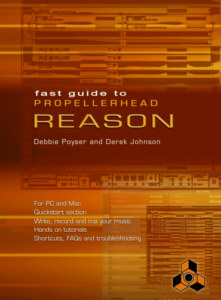 |
Here
we go...
So
the first thing that is explained is of course the installation and the correct
setup of Reason. You
get to know what kind of hardware you need to run Reason and
how to setup Midi for Windows, MAC OMS and OSX.
When
you have setup Reason and it is running you can turn to the next chapter, the
quickstart tutorials. This is for the impatient people (like me) who must try
out everything before reading too much once the program is running.
And
if those impatient people had some problems with the operation of Reason, they
should now read the chapter about basic Reason operations like loading and
saving a song, the difference between a normal and a selfcontained song, what
can be done with the rack devices, where to stick those cables, what
Refills are needed for and much more.
A
nice feature is that throughout the whole book you can find small boxes with tips.
And
finally, on page 58 (!) we start with the stuff we all really waited for. One
intensive chapter for every Reason device:
The Remixer
Here
you are told what all these tiny knobs and faders are for. You learn the
difference between insert and send effects, how automatic cable connections work
and when you should not use them. And just in case you don’t know what a
chained submixer is, this is explained here too.
The Subtractor
As
many people already know, the Subtractor is my Precious One, so I read this
chapter most carefully. I still remember the first time I sat in front of the
Subtractor, thinking "Now what am I supposed to do now with all those
different knobs ?“ Get familiar with everything with a small tutorial in
which you learn to create a bass sound.
There’s
a small info box telling you that this is not an in-depth exploration of
Subtractors theory, analogue synthesis. But everything you need to know is
explained.
Next
comes a tutorial, where you can make your own drum sounds.
Okay, you might say, this is what I have the Redrum for, but it is my
opinion that self-made drumsounds have their special charm.
My
favourite tutorial is in this chapter too. Here you can read how you can create
a Roland TB 303 sound. (Think I have to write faster to get ready and try
this
out !!)
And
after reading the Subtractor chapter you will know how to create rich, phatt
sounds by using a patch layering technique.
The Redrum
Again
the first you learn here is the use of all the buttons. You will be guided
through the process of setting up a drum pattern in a tutorial.
Also explained is my favourite Redrum technique, the "Copy Pattern to
Track“ function. This allows to edit a drumtrack in the sequencer to make it
sound more "human“.
When
you have succeeded in setting up one or more drumsounds in the Subtractor
chapter, then it is now time to try it out by letting Redrum trigger up to 10
Subtractors.
As
in every other chapter, the backside of this device with the setting up of all
that cable-spaghetti is also described in detail.
NN19
The
original Reason sampler is the topic of the next chapter. Here you can read
about mapping, automapping, keyzones and keymap templates.
Dr:rex
Again
this is not a chapter full of theory only, Debbie and Derek take you by your
hands and show you how to use Dr:rex in a tutorial. Afterwards in a guided tour
all the features of Dr:rex are explained. They don’t forget the rear panel (of
D:rex!) and show you how the Dr:rex loops are used in the sequencer.
Malström
The
first tip in this chapter is about something that I also realized when I made my
first experiments with Malström: Certain filter settings can produce resonances
that can could possibly hurt your speakers and your ears. So it is advised to
use a compressor on Malströms output.
After
taking this precaution you can try out the guided tour where you get familiar
with all the aspects of graintable synthesis. Again you are presented a
programming example so that you can turn the knobs while reading. Also covered
is the use of Malström as a signal processor for other devices.
NNXT
In
principle the NNXT is the same as the NN19, but it offers much more
possibilities of controlling the samples. All those extended (NNXT)
possibilities are explained of course and after you have finished the
chapter you will know how to create a layered patch, how to make velocity-crossfade
layers and how sample looping in NNXT works. The most valuable content of this
chapter are the guidelines about setting loop points so that the samples don’t
click or bump. And on two pages you will find some new ideas what you can do
with the NNXT that are not in the manual.
Matrix
This
friend of all laptop Reason users is called
"secret weapon of Reason“ here. I could not have it formulated that
better. You get the usual guided tour in this chapter and learn about chaining
patterns in various ways. Then it’s "TAB“ time again, switch to the rear
panel of Matrix and try some auto-panning, a faked sync’d LFO or arpeggios.
Also included is the "Playing
the Matrix with a midi-keyboard“ technique that is described on the Tips
and Tricks page of this website. They even have expanded that a little further !
Rebirth Input
People who own Reason’s
predecessor and use it together with Reason will be pleased that there’s a
chapter about the Rebirth Input Machine (RIM) too.
Effects
Last
not least there’s a huge chapter about effets. On 40 pages, individual aspects
of the different effects are covered.
Sequencer
This
chapter explains the basics of a sequencer and in detail all the options you
need to know when using the Reason sequencer.
From
the letters I got the last months I know that many people miss a tempo-changing
feature in Reason. For these people the last paragraph in the sequencer chapter
called "Faking Tempo Changes“
will be most interesting.
Automation And Remote Control
A Reason song without
automation is like a dinner without spices, so
if you want to give you songs more substance, read this !
And
the rest...
There’s a a chapter how to
use Reason with other software. Connect Reason to Cubase VST, Nuendo or SX or
Emagic Logic, Motu Digital Performer or Cakewalk Sonar. Debbie and Derek
even explain how to use Reason with non-Rewire programs like Pro Tools LE via
Hubis Loopback device.
At the end of the book you
also get 20 fast Reason tips, a fast guide to CV/Gate routings and a listing of
the best websites around Reason, audio and recording
Conclusion:
This
book really got me !! I had to explain my wife why I interrupted the reading of
the Stephen King book she gave me for Christmas.
My
first fear when I heard about a new Reason book was that it would be another
kind of manual. But this book offers much more. It really stimulates you to
experiment with Reason.
Beginners
will habe no problems because everything you need to know is explained in detail
with numerous black and white illustrations But the users who already have
some Reason knowledge are not forgotten either. There is so much new inside that
needs to be tried out.
The
book is if course written for the new Reason V.2, but it is even valuable for
users that still use the V.1. After you read that Malström chapter, I am sure,
your wish to upgrade will arise ;-)
There are only two words for me
to say: Deeply Recommended !
Debbie
Poyser and Derek Johnson, Fast Guide to PROPELLERHEAD REASON, 408 pages, ISBN
187 077 5813, £ 22,95
If
I could wet your mouth now, here is where you can order it: PC-Publishing
A German manual is available
for Reason !
You can download it at the Propellerheads
website.
"Reason in der
Praxis" was written by Thomas Alker, has 214 pages and costs DM 39.
|
There is a Germany translation of this article
here
I thought it would be fair to let the people who don't understand German know, what they are missing. ;-) And who knows, perhaps some foreign publisher is interested to translate
this book sometime.
The Book begins with the Installation and Configuration of Reason, with a small troubleshooting section. Then the whole concept of Reason is explained, followed by a detailed description of the Reason rack, front and behind, including the concept of the virtual cables.
Two detailed chapters cover the Sequencer and how to work with it.
Then it's time to introduce the various Reason modules: Subtractor, NN19 sampler, Dr.Rex, Matrix and
Redrum. Following these are the mixer and the different effects. Next you learn something about Automation and Remote Control.
If you ever tried to connect Cubase with Reason, you know how tricky this can be, the chapter about Rewire should give you some relief.If you are finished with these chapters, you have reached 2/3 of the book. Everything that follows now can't be found in the Reason manual.
My most favourite chapter is the Tips section. Okay, I admit that it is my favourite because you can find two tips from this website there too... ;-) |
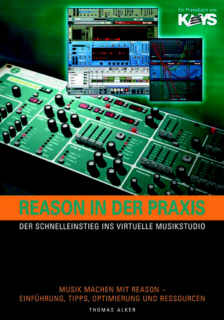 |
If you plan to use Reason on a Notebook, you get some advice too. And if you are not satisfied with the amount of sounds of the NN19, you are introduced to some sampling CDs.
In the chapter "Cult and Community" you find interviews with Ernst Nathorst Böös of the Propellerheads and some people of the Reason Community.
In the last chapter you can find some last-minute infos about the Reason 1.0.1 update and the Refill packer.
And for all those people who have not yet discovered Reason websites on the Internet, there is the appendix with various Reason links.
If you are not a Reason owner yet, don't despair ! On the CD that comes with the book is the new Reason Demo 1.0.1. so that you can have a try at once.
You also can find the Cubase 5 demo there, this is your last chance to get this, as Steinberg already has removed that from their Website.
Other stuff from the CD are:
Rebirth and Recycle demos,
Reason song files with the examples from the tips section,
shareware programs: Arp-X8, Midi Translator and Mouse Keyboard
some demo sampling sounds
And now the final question: Can I recommend the book ? The answer is YES ! Especially if you are a Reason beginner and you have some difficulties with the English manual. The book is written in an easy understandable style and good value for money !
Thomas Alker, Reason in der Praxis, 214 pages with CD, DM 39, ISBN 3-932275-22-5
"Reason in der Praxis" wurde geschrieben von Thomas
Alker, es hat 214 Seiten und kostet DM 39.
Das Buch beginnt mit der Installation und Konfiguration von Reason, inclusive einem Problemlösungsteil. Danach wird das Konzept von Reason erklärt, gefolgt von einer ausführlichen Beschreibung des Reason Racks,
Vorder- und Rückseite, inclusive einer Beschreibung der virtuellen Kabel. Zwei detaillierte Kapitel behandeln den Sequencer und wie man damit
arbeitet.
Danach ist es Zeit, die verschiedenen Reason-Module vorzustellen: Subtractor, NN19 sampler,
Dr.Rex, Matrix and Redrum. Anschließend werden der Mixer und die verschiedenen Effekte
behandelt, es folgen die Themen Automation und Remote Control.
Jeder, der irgendwann schonmal versucht hat, Cubase mit Reason zu verbinden, weiß wie schwierig sich das gestalten
kann. Das Kapitel über Rewire kann hier mehr Licht ins Dunkel bringen. Nachdem man diese Kapitel gelesen hat, ist 2/3 des Buchs
erreicht. Alles was jetzt folgt, kann man nicht in der Reason Anleitung finden.
Mein Lieblingskapitel ist "Die besten Tips rund um Reason". Okay, ich gebe zu, das liegt
daran, daß zwei der Tips von dieser Website sind.. ;-) Wer plant, Reason auf einem Notebook
einzusetzen, bekommt dafür ebenfalls Tips. Und falls einem die Sampler Sounds von Reason nicht
reichen, werden einige Sampling CDs vorgestellt.
Im Kapitel "Kult und Community" finden sich Interviews mit Ernst Nathorst Böös von den Propellerheads und einiger Leute der Reason Community.
Im letzen Kapitel findet man schließlich noch einige allerneueste Informationen über das Reason 1.0.1 Update und den Refill Packer.
Und für alle, die die zahlreichen Reason Websites im Internet noch nicht entdeckt
haben, befinden sich im Anhang zahlreiche Links.
Falls man noch kein Reason Besitzer ist, kein Grund zur Verzweiflung ! Auf der beigelegten CD befindet sich das neueste Reason Demo 1.0.1, so daß man sofort loslegen
kann. Auch das Demo von Cubase 5 ist auf der CD, vielleicht die letzte
Gelegenheit, es zu bekommen, da es auf der Steinberg Website schon nicht mehr zu
finden ist..
Außerdem ist auf der CD noch enthalten:
Demos von Rebirth und Recycle
Reason Song Dateien mit den Beispielen aus dem Tip- Kapitel
Shareware Programme: Arp-X8, Midi Translator and Mouse Keyboard
einige Samplingsounds-Beispiele
Und nun die alles entscheidende Frage: Kann ich diese Buch empfehlen ? Die Antwort ist JA ! Besonders der
Reason-Anfänger, der sich nicht mit der englischsprachigen Anleitung anfreunden
kann, sollte unbedingt zugreifen. Das Buch ist leichtverständlich und wirklich sein Geld wert !
Thomas Alker, Reason in der Praxis, 214 Seiten mit CD, DM 39, ISBN 3-932275-22-5
Analog Synthesis : The Newbie Guide to
Synthesizers and Sound Design. by Reinhard Schmitz $
23,96
Analoge Klangsynthese Das Einsteigerbuch
zu Synthesizern und Soundprogrammierung DM 39,80
| This is a very useful book for
everyone who wants to understand the Subtractor or any other virtual or
hardware synthesizer. It is available in English and in German.
On 130 pages you can read about the
basics of a synthesizer, how sounds can be generated using oscillators,
filters, amplifiers, envelopes and LFOs.
In another chapter you can learn
something about effects. And the best is that you can try all this stuff
with the Subtractor. Included to the book is an audio CD with many audio
examples of so that you can control whether you turned the correct
knobs. |
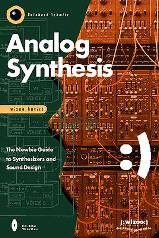
|
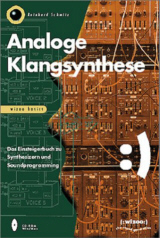
|
Vintage Synthesizers by Marc Vail $
22.36
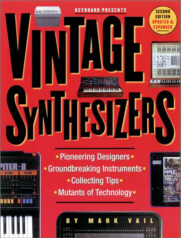 |
This was my first book about
synthesizers. It is something like a history book. Each chapter deals
with another old synthesizer company, some were more successful, some
less.
On 333 large pages with many photos,
(mostly with long-haired guys in front of cupboard-large equipment with
cable-spaghetti ;-) ) you can read stories about the beginnings of
electronic music.
Read about the rise and fall of Moog
Music, about Wendy Carlos and her "Switched-On Bach" project,
about a company called ARP, about Keith Emerson and his moog, about the
Mellotron in Led Zeppelin's "Rain Song" and many other
entertaining stuff.
So if you are interested in the
backgrounds and history of electronic music, this book is highly
recommended !! |




